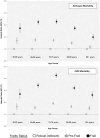Measuring Frailty Using Self-Report or Automated Tools to Identify Risk of Cardiovascular Events and Mortality: The Million Veteran Program
- PMID: 39158558
- PMCID: PMC11963909
- DOI: 10.1161/JAHA.123.033111
Measuring Frailty Using Self-Report or Automated Tools to Identify Risk of Cardiovascular Events and Mortality: The Million Veteran Program
Abstract
Background: Frailty, a syndrome of physiologic vulnerability, increases cardiovascular disease (CVD) risk. Whether in person or automated frailty tools are ideal for identifying CVD risk remains unclear. We calculated 3 distinct frailty scores and examined their associations with mortality and CVD events in the Million Veteran Program, a prospective cohort of nearly 1 million US veterans.
Methods and results: Veterans aged ≥50 years and enrolled from 2011 to 2018 were included. Two frailty indices (FI) based on the deficit accumulation theory were calculated: the questionnaire-based 36-item Million Veteran Program-FI and 31-item Veterans Affairs-FI using claims data. We calculated Fried physical frailty using the self-reported, 3-item Study of Osteoporotic Fractures. Multivariable-adjusted Cox models examined the association of frailty by each score with primary (all-cause and CVD mortality) and secondary (myocardial infarction, stroke, and heart failure) outcomes. In 190 688 veterans (69±9 years, 94% male, 85% White), 33, 233 (17%) all-cause and 10 115 (5%) CVD deaths occurred. Using Million Veteran Program-FI, 29% were robust, 42% pre-frail, and 29% frail. Frailty prevalence increased by age group (27% in 50-59 to 42% in ≥90 years). Using the Million Veteran Program-FI, over 6±2 years, frail veterans had a higher hazard of all-cause (hazard ratio [HR], 3.05 [95% CI, 2.95-3.16]) and CVD mortality (HR, 3.65 [95% CI, 3.43-3.90]). Findings were concordant for the Veterans Affairs-FI and Study of Osteoporotic Fractures frailty definitions, and remained significant even among younger veterans aged 50-59 years.
Conclusions: Irrespective of frailty measure, frailty is associated with a higher risk of all-cause mortality and adverse CVD events. Further study of frailty in veterans aged <60 years old is warranted.
Keywords: cardiovascular disease; frailty; risk stratification.
Figures


References
-
- Centers for Disease Control and Prevention . CDC WONDER. [Internet]2021. Accessed February 23, 2022. https://wonder.cdc.gov/.
-
- Office of Disease Prevention and Health Promotion . Heart disease and stroke. Health People 2030.

